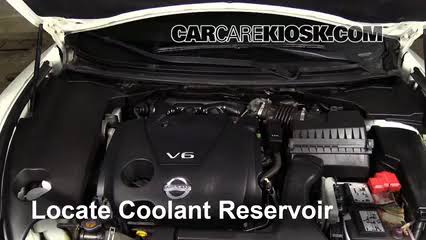Cooling Confidence: A Comprehensive Guide to Antifreeze for Nissan Maxima
In the realm of midsize sedans, the Nissan Maxima stands out for its performance, style, and reliability. Behind the scenes of its powerful engine lies a critical component responsible for regulating engine temperature and preventing overheating: antifreeze. In this blog, we’ll explore everything you need to know about antifreeze for the Nissan Maxima, including its function, types, maintenance tips, common issues, and replacement guidelines, ensuring your Maxima stays cool and confident on the road.
Understanding Antifreeze in the Nissan Maxima
Function:
Antifreeze, also known as coolant, is a specially formulated liquid designed to regulate engine temperature by absorbing and dissipating heat generated during combustion. It circulates through the engine and radiator, transferring heat away from the engine components and maintaining optimal operating temperature.
Components:
Antifreeze consists of a mixture of water and ethylene glycol or propylene glycol, along with corrosion inhibitors, lubricants, and other additives. These additives help protect the cooling system from corrosion, scale buildup, and freeze damage, ensuring long-term reliability and performance.
Types of Antifreeze
Ethylene Glycol Antifreeze:
Ethylene glycol antifreeze is the most common type used in automotive applications, including the Nissan Maxima. It offers excellent heat transfer properties and freeze protection, making it suitable for a wide range of climates and driving conditions.
Propylene Glycol Antifreeze:
Propylene glycol antifreeze is an alternative to ethylene glycol, offering similar performance and compatibility with automotive cooling systems. It is less toxic and safer for the environment, making it a popular choice for eco-conscious drivers.
Common Issues with Antifreeze
Coolant Leaks:
Coolant leaks can occur due to damaged hoses, gaskets, seals, or radiator components, resulting in a loss of coolant and potential engine overheating. Leaks should be identified and repaired promptly to prevent engine damage and overheating.
Cooling System Corrosion:
Corrosion can occur inside the cooling system due to electrolysis, chemical reactions, or exposure to contaminants in the coolant. Corrosion can lead to coolant leaks, overheating, and damage to cooling system components, necessitating system flushing and treatment with corrosion inhibitors.
Overheating:
Overheating can occur due to low coolant levels, coolant leaks, malfunctioning thermostat, or restricted airflow through the radiator. Overheating can cause engine damage, cylinder head warping, and gasket failure, requiring immediate attention and repair.
Maintenance Tips for Antifreeze
Regular Inspections:
Inspect the coolant level and condition regularly, checking for signs of leaks, contamination, or discoloration. Ensure the radiator cap and coolant reservoir are properly sealed and functioning, and top up the coolant as needed with the appropriate type and mixture ratio.
Coolant Flush:
Flush the cooling system and replace the coolant at regular intervals, as recommended by the manufacturer or based on driving conditions and climate. Flushing removes old coolant, debris, and contaminants from the system, ensuring optimal performance and longevity.
Pressure Test:
Perform a pressure test on the cooling system to check for leaks, weak spots, or faulty components. A pressure test can help identify potential issues before they lead to coolant loss, overheating, or engine damage.
Replacement Guidelines for Antifreeze
Signs for Replacement:
Replace the antifreeze in your Nissan Maxima if you notice any of the following signs:
- Low coolant level or loss of coolant
- Discoloration or contamination of the coolant
- Overheating or engine temperature fluctuations
Replacement Procedure:
- Drain the Coolant: Start by draining the old coolant from the radiator and engine block using the drain plugs or petcock valves. Dispose of the old coolant properly according to local regulations.
- Flush the Cooling System: Flush the cooling system with clean water to remove any remaining coolant, debris, or contaminants. Use a flushing agent or radiator cleaner if necessary to remove scale or buildup.
- Refill with New Coolant: Refill the cooling system with the appropriate type and mixture ratio of new coolant, ensuring it meets the manufacturer’s specifications for your Nissan Maxima. Use a funnel to prevent spills and air pockets.
- Bleed the Air: Bleed any air trapped in the cooling system by opening the radiator cap or bleed valve and running the engine with the heater on until the coolant reaches operating temperature. Top up the coolant as needed and recheck for leaks.
- Test and Inspect: Test-drive the vehicle and monitor the engine temperature to ensure proper cooling system operation. Check for any signs of leaks, overheating, or coolant loss, and address any issues promptly.
Conclusion
Antifreeze is a vital component of the cooling system in the Nissan Maxima, ensuring optimal engine temperature regulation and performance in all driving conditions. By understanding its function, recognizing common issues, following proper maintenance tips, and knowing when to replace it, you can ensure that your Maxima stays cool and confident on the road. Regular inspections, coolant flushes, and timely replacement of old coolant are essential steps in maintaining cooling system reliability and longevity, allowing you to enjoy worry-free driving for miles to come.




Post Comment